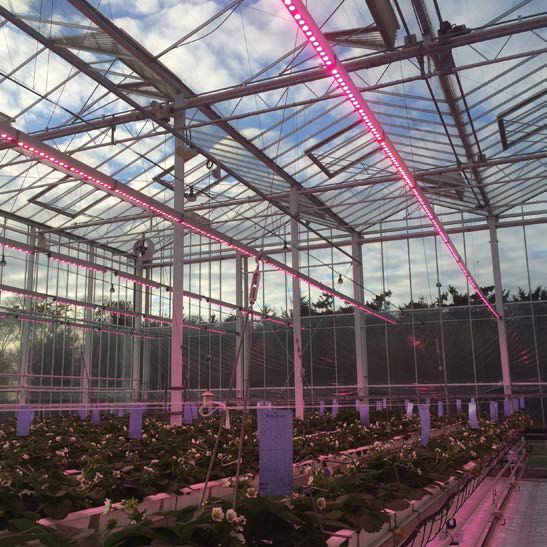Dr Eamonn Kehoe, Teagasc Soft Fruit Specialist, outlines the benefits of using light supplementation in berry crops
One of the recent webinars run for soft fruit growers focused on the latest advances in the use of light supplementation. The presentation was given by two speakers from Philips N.V. Philips is one of the biggest electronics companies in the world. They are also one of the leaders in lighting technology and have a specialised unit devoted to lighting in various horticultural crops.Their centre of excellence is based in Eindhoven, in the Netherlands and as a result Eindhoven is often called the ‘Philips city’. Peers Hermans,the main horticultural lighting specialist gave an amazing presentation on the benefits of light supplementation, focusing specifically on strawberry crops.
Light supplementation is primarily delivered by using light-emitting diodes (LEDs). Technology development has allowed for many husbandry improvements. An LED light
array can be designed for a specific crop and tailored for a particular part of the growing season. The amount of white, red and far-red light, for example, needed by a grower for
their crop can be engineered in the factory.
LEDs are also very energy efficient. delivering huge energy savings and a much lower carbon footprint. For example, a 9w LED will give a similar light output as a 100w
incandescent light bulb. Growers in Ireland mostly use incandescent light bulbs as ‘night break’ lights. Night-break lighting is needed to break crop dormancy. Without this
treatment, crop yields and strawberry quality are much lower. Night-break lighting is even more crucial during a mild winter when the strawberry crop receives inadequate chilling.
Philips ‘GreenPower 2.0 ‘night break’ lights were recently installed in our strawberry glasshouse units in Teagasc, Ashtown Research Centre. The light produced gives the optimum amounts of deep red, white and far-red radiation for the strawberry crop. The lights are used for about 40 days, once the strawberry crops begin to actively grow. The lights are working extremely well, and are also delivering energy efficiency of over
90 per cent compared to incandescent light bulbs.
Can We Grow Strawberries All Year Long?
LED technology offers huge potential for the strawberry industry. In the Netherlands,at least 40 hectares of heated glass are now using LED lights to grow strawberries all year long. This means Dutch consumers can buy strawberries for the lucrative Christmas market
and Dutch producers can command a higher price for their produce. The Philips scientists expect the use of LED light treatment to increase quickly as growers adopt the new technology. More research and development is ongoing, exploring the effects of the LED lights on crop growth but also beneficial insects and bumblebees. So far the bumblebees do not seem to be affected by the LED light wavelengths.
Extension of the Crop Season
LED’s could also have a big role to play in the season extension of ever-bearing strawberries. Ever-bearing strawberries are very dependent on a combination of increased temperature and increased day length to continue to flower and produce fruit. Whilst the temperature in a heated glasshouse could always be controlled, controlling the day length in spring and autumn was not possible. Peers Hermans described several examples where growers in Belgium and the Netherlands were now able to extend the growing season using LED lights. This means, for example, that a grower could continue to pick an ever-bearer
crop well into the winter without any loss of fruit quality. The scientists maintain that the fruit quality is improved when LED supplementation is used for all berry crops. ✽
  DR EAMONN KEHOE is a soft fruit adviser and research scientist with Teagasc. For more information contact: eamonn.kehoe@teagasc.ie |








